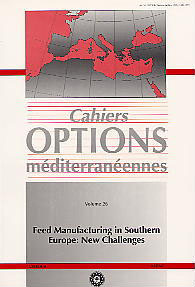| Article précédent | p. 119-123 | Article suivant |
The cell wall and its components in cereals and pulse grains, consequences on nutritional value
The author describes components present in the cell wall of cereals and pulse grains and explains how polysaccharides are chemically made up. It is essential to find out the composition of cereals, in any case, the analytical methodology used is a very important issue. As regards arabinoxylans, components with a high water absorbing capacity, they are studied regarding the specificity of the industrial enzymes currently available. In conclusion, enzymes according to their specificity in the coupling place on the substract (polysaccharides) produce final results which might be positive or negative. Therefore, the enzyme characteristics, which are or not endo- or exoxylanases, should be considered as a very important issue in enzyme formulation in the feeding industry. Enzymes influence solubility of starch and proteins from polysaccharides, so that there is an enhancement of the kinetics of digestion and production of bioactive polymers. Finally, today there is a new approach of oligosaccharides which may help and stimulate the development of intestinal conditions helping the intestinal probiosis against zoonosis, such as Salmonella and E. coli.
- [ Afficher ]
- [ Télécharger ]
- [ Exporter la citation ]
Vous pouvez télécharger la citation au format :
- [ Imprimer ]
-
Mots-clés
CEREALE, ENZYME, LEGUMINEUSE A GRAINS, PAROI CELLULAIRE, POLYHOLOSIDECiter cet article
Voragen A.G. The cell wall and its components in cereals and pulse grains, consequences on nutritional value. In : Morand-Fehr P. (ed.). Feed manufacturing in Southern Europe: New challenges. Zaragoza : CIHEAM, 1997. p. 119-123. (Cahiers Options Méditerranéennes; n. 26). South European Feed Manufacturers Conference, 1996/05/09-11, Reus (Spain). http://om.ciheam.org/om/pdf/c26/97605978.pdf



